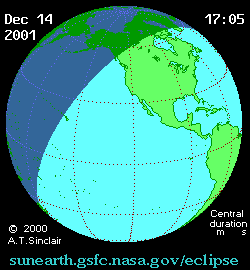Nature Annular Magnitude 0.9681 Max. width of band 126 km (78 mi) Start date December 14, 2001 | Gamma 0.4089 Duration 233 sec (3 m 53 s) Greatest eclipse 20:53:01 | |
 | ||
An annular solar eclipse occurred on December 14, 2001. A solar eclipse occurs when the Moon passes between Earth and the Sun, thereby totally or partly obscuring the image of the Sun for a viewer on Earth. An annular solar eclipse occurs when the Moon's apparent diameter is smaller than the Sun's, blocking most of the Sun's light and causing the Sun to look like an annulus (ring). An annular eclipse appears as a partial eclipse over a region of the Earth thousands of kilometres wide. It was visible across the Pacific ocean and North America. The central shadow passed just south of Hawaii in early morning and ended over Central America near sunset.
Contents
Solar eclipses 2000-2003
Each member in a semester series of solar eclipses repeats approximately every 177 days and 4 hours (a semester) at alternating nodes of the Moon's orbit.
Note: Partial solar eclipses on February 5, 2000 and July 31, 2000 occur in the previous lunar year set.
Saros 132
It is a part of Saros cycle 132, repeating every 18 years, 11 days, containing 71 events. The series started with partial solar eclipse on August 13, 1208. It contains annular eclipses from March 17, 1569 through March 12, 2146, hybrid on March 23, 2164 and April 3, 2183 and total eclipses from April 14, 2200 through June 19, 2308. The series ends at member 71 as a partial eclipse on September 25, 2470. The longest duration of annular was 6 minutes, 56 seconds on May 9, 1641, and totality will be 2 minutes, 14 seconds on June 8, 2290.
Metonic cycle
The metonic series repeats eclipses every 19 years (6939.69 days), lasting about 5 cycles. Eclipses occur in nearly the same calendar date. In addition the octon subseries repeats 1/5 of that or every 3.8 years (1387.94 days).
